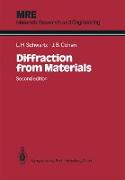Diffraction from Materials
BücherAngebote / Angebote:
The atomic arrangements in condensed matter play an ever increasing role in many areas of science and technology - Materials Science and Engineering, Chemistry, Physics, Geology, Biology and Electrical, Civil, Mechanidtl and Chemical Engineering. Exciting discoveries in these fields in this century often stemmed from studies of these arrangements using diffraction: the structure and functions of DNA and other biological molecules, the configuration of polymer chains, the crystalline nature of metals and their imperfections, semiconductors and insulators, and -the links between their structures, their defects and material properties, and the interaction between materials and the environment. The broad, interdisciplinary character of diffraction studies makes them particularly exciting. With new tools such as the high-resolution electron microscope, new detectors, new techniques (such as EXAFS and glancing angle diffraction) and the new sources, the horizons of this field greatly expanded in the 1950's and 60's. Pulsed neutron sources and high intensity storage rings that came on the scene in the late 70's have opened up possibilities for new study to such vast horizons that it is hard to sit here writing this - there's so much to be done! Within the walls bounding each field of science or engineering, diffraction and structure is only one specialty. It is too easy for this topic to be developed in such a narrow way that sight is lost of the basic principles and broad possibilities.
Folgt in ca. 5 Arbeitstagen




